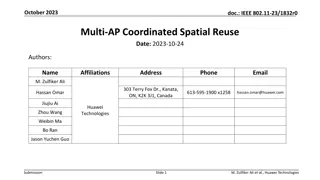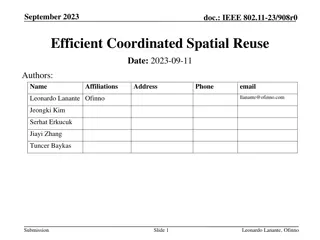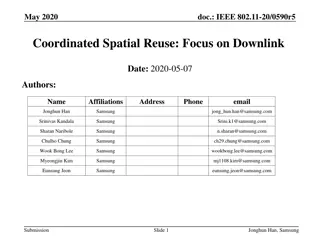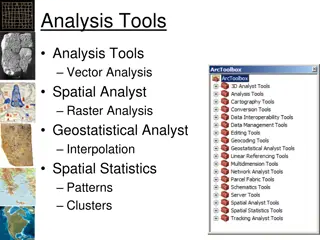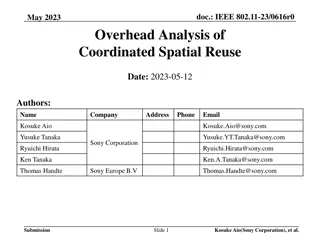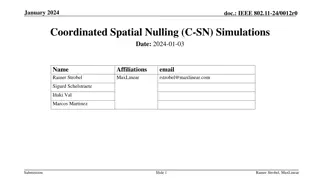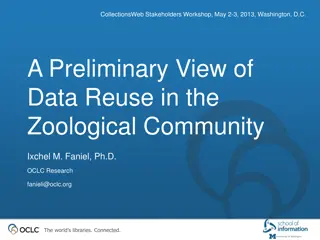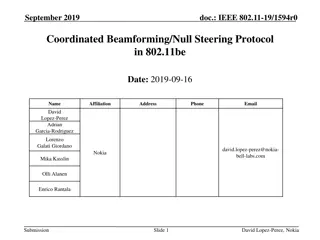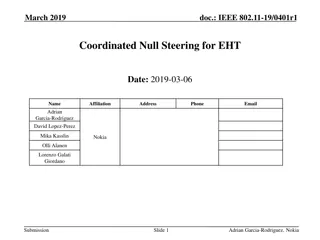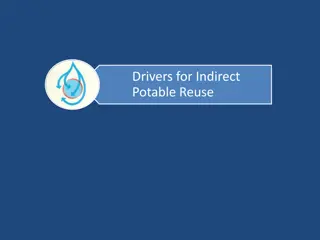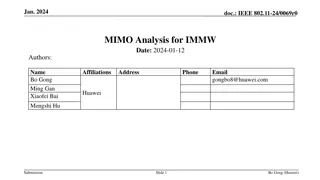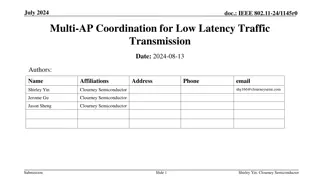Understanding IEEE 802.11-20/0410r4 Coordinated Spatial Reuse Procedure
This document presents the Coordinated Spatial Reuse (CSR) procedure in IEEE 802.11-20/0410r4, focusing on the transmission schemes and necessary information for effective spatial reuse. It outlines the topology of CSR environments, acquisition of information for CSR, CSR capability announcement by APs, and measurement announcements to STAs. The CSR operation aims to minimize interference and enhance transmission efficiency among neighboring APs and STAs.
Download Presentation

Please find below an Image/Link to download the presentation.
The content on the website is provided AS IS for your information and personal use only. It may not be sold, licensed, or shared on other websites without obtaining consent from the author. Download presentation by click this link. If you encounter any issues during the download, it is possible that the publisher has removed the file from their server.
E N D
Presentation Transcript
March 2020 doc.: IEEE 802.11-20/0410r4 Coordinated Spatial Reuse Procedure Date: 2020-03-16 Authors: Name Affiliation Address Phone Email Sungjin Park allean.park@lge.com Jeongki Kim jeongki.kim@lge.com Suhwook Kim suhwook.kim@lge.com 19, Yangjae-daero 11gil, Seocho-gu, Seoul 137- 130, Korea Insun Jang LG Electronics insun.jang@lge.com Taewon Song taewon.song@lge.com Namyeong Kim namyeong.kim@lge.com Jinsoo Choi js.choi@lge.com Slide 1 Sungjin Park, LG Electronics
March 2020 doc.: IEEE 802.11-20/0410r4 Introduction The Coordinated Spatial Reuse (CSR) operation can be one of the Multi-AP transmission schemes with relatively low complexity. Before the CSR transmission, the STA participating in CSR needs measurement phase to know the path loss from OBSS APs. Solicited method (by NDP sounding) Unsolicited method (by ongoing packet) This contribution proposes the CSR procedure based on unsolicited method. Slide 2 Sungjin Park, LG Electronics
March 2020 doc.: IEEE 802.11-20/0410r4 Topology of CSR We consider the following environments. Each AP can establish its own BSS STA a and STA b are associated with AP 1 in BSS 1. STA c and STA d are associated with AP 2 in BSS 2. APs are connected each other with wireless backhaul. APs which are hearable each other can participate in the CSR transmission. Slide 3 Sungjin Park, LG Electronics
March 2020 doc.: IEEE 802.11-20/0410r4 Necessary information for CSR In order to control the TX power to mitigate interference that an AP gives to the OBSS STA, the following information is required. a) TX Power, b) RSSI, c) DL Acceptable Receiver Interference Level (DL ARIL)* *DL ARIL: the value of the DL RSSI (AP 1 to STA a) minus the minimum SNR value that yields 10% PER for the highest MCS of the ensuing DL PPDU, minus a safety margin value not to exceed 5 dB as determined by the AP. Based on above information, the maximum TX power to be used for CSR is determined as follows: Max CSR TX power (AP 2) TX Power (a) RSSI (b) + DL ARIL (c) The following slides introduce how to acquire these information and how to use these information for CSR. Slide 4 Sungjin Park, LG Electronics
March 2020 doc.: IEEE 802.11-20/0410r4 CSR capability announcement APs can discover each other by receiving Beacon frame or management frames sent by neighboring APs. When the AP sends Beacon frame or management frame, the neighboring AP should be informed that there is a capability and an intention to participate in CSR operation. [1] APs know which of neighboring APs is hearable and has CSR capability and intention. Slide 5 Sungjin Park, LG Electronics
March 2020 doc.: IEEE 802.11-20/0410r4 Measurement announcement The AP gives the list of neighboring APs to the STA(s) associated with itself. The AP may compose the list with only a few of neighboring APs which have capability and intention to participate in the CSR. A STA that received the list of neighboring APs starts to measure RSSI from neighboring APs in the list. The STA measures the RSSI by using ongoing packet transmitted by the neighboring APs in the list. The STA may update the average RSSI value when ongoing packet is received. Slide 6 Sungjin Park, LG Electronics
March 2020 doc.: IEEE 802.11-20/0410r4 Measurement result request & report The AP requests the own STA(s) to report the measured RSSI from the neighboring APs and the associated AP. The STA reports the following information to its associated AP: Measured RSSI from the neighboring APs Measured RSSI from the associated AP The AP computes the DL Acceptable Receiver Interference Level (DL ARIL) based on the Measured RSSI from the associated AP. Slide 7 Sungjin Park, LG Electronics
March 2020 doc.: IEEE 802.11-20/0410r4 CSR setup The AP which obtains TXOP to send data to the STA a can be the Sharing AP. [1] The Sharing AP selects the candidate AP and informs as follows: For DL TX (Data) Measured RSSI (candidate AP STA a) DL ARIL (Sharing AP STA a) The candidate AP responds to the Sharing AP if the channel state is idle. [2] Slide 8 Sungjin Park, LG Electronics
March 2020 doc.: IEEE 802.11-20/0410r4 CSR trigger The Sharing AP finally selects which candidate AP is the Shared AP. The Sharing AP triggers the Shared AP and informs as follows: For DL TX (Data) Available DL TX time for the Shared AP For UL TX (ACK) Resource allocation where Shared AP will receive the ACK frame in response to DL data (Shared AP will allocate RU to own STA within this resource allocation) The start time to send the ACK frame Slide 9 Sungjin Park, LG Electronics
March 2020 doc.: IEEE 802.11-20/0410r4 CSR data transmission The Sharing AP sends data to the STA a and the Shared AP sends data to the STA c concurrently. The Shared AP should determine max TX power as follows: max CSR-TX power TX power of Shared AP RSSI ARIL (Sharing AP STA a) The Shared AP selects the STA c if it is satisfied with following condition: Updated DL ARIL (Shared AP STA c) RSSI RSSI (Shared AP STA a) + DL RSSI (Sharing AP STA c) * TX power & RSSI: it can be set to the average value measured ** Updated DL ARIL: DL ARIL value can be changed when max CSR-TX power is determined and then min SNR(10% PER) is determined according to the max CSR-TX power . (Updated DL ARIL = max CSR-TX power path loss min SNR(10% PER) safety margin) Slide 10 Sungjin Park, LG Electronics
March 2020 doc.: IEEE 802.11-20/0410r4 Example of CSR data transmission DL ARIL of STA a: TX power of Sharing AP path loss min SNR (10% PER) = 24 88 23 = - 87 dBm RSSI of STA a: TX power of Shared AP path loss = 24 106 = - 82 dBm Max TX power of Shared AP: path loss + ARIL = 106 87 = 19 dBm Updated DL ARIL of STA c: max TX power path loss min SNR (10% PER) = 19 70 32 = - 83 dBm Min distance of x: Satisfying the condition (Updated DL ARIL RSSI ) = 105 m : Logical coverage of Sharing AP : Logical coverage of Shared AP When the Sharing AP transmits a data to STA a , the Shared AP can use only limited TX power that does not interfere with STA a . When the Shared AP uses limited TX power, a data can be transmitted only to the STA which is satisfied with certain condition. Updated DL ARIL (Shared AP STA c) RSSI (Sharing AP STA c) Slide 11 Sungjin Park, LG Electronics
March 2020 doc.: IEEE 802.11-20/0410r4 ACK transmission The ACK transmission from the STAs received CSR data frame can be performed by UL-OFDMA. STA a sends the ACK frame to the Sharing AP through allocated RU which is indicated in the Data frame sent by Sharing AP. STA c sends the ACK frame to the Shared AP through allocated RU which is indicated in the Data frame sent by Shared AP. The Shared AP includes the RU allocation in the Data frame as the Sharing AP indicates through the trigger frame. Slide 12 Sungjin Park, LG Electronics
March 2020 doc.: IEEE 802.11-20/0410r4 Summary of CSR procedure The RSSI measurement by using ongoing packets to acquire path loss is performed in the CSR preparations. The phases of CSR Setup, CSR Trigger, CSR Data & Ack are performed within single TXOP after the Sharing AP obtains TXOP. Slide 13 Sungjin Park, LG Electronics
March 2020 doc.: IEEE 802.11-20/0410r4 Conclusion The Coordinated Spatial Reuse (CSR) operation can be supported with relatively low complexity by using ongoing packet from OBSS. It doesn t necessarily need the NDP sounding operation which is to acquire CSI between the APs and STAs which is not associated with those APs. Relatively low requirement of synchronization compared to Joint TX scheme, Coordinated BF scheme. This contribution proposes the CSR procedure based on unsolicited method. Slide 14 Sungjin Park, LG Electronics
March 2020 doc.: IEEE 802.11-20/0410r4 Appendix 1 Path loss (5GHz, TGnD) Slide 15 Sungjin Park, LG Electronics
March 2020 doc.: IEEE 802.11-20/0410r4 Appendix 2 Effective SNR (TX power: 24dBm, 80MHz, Noise Figure 5dB) Slide 16 Sungjin Park, LG Electronics
March 2020 doc.: IEEE 802.11-20/0410r4 Appendix 3 PER (MCS 0~9, SISO, 1000bits, 80MHz, TGnD) Slide 17 Sungjin Park, LG Electronics
March 2020 doc.: IEEE 802.11-20/0410r4 Straw Poll 1 Do you agree to add the following text to the TGbe SFD: An AP informs the list of neighboring APs which have capability to participate in Coordinated Spatial Reuse (CSR) to the STA(s) associated with itself and requests the STA(s) to measure the RSSI from the neighboring APs in the list. Slide 18 Sungjin Park, LG Electronics
March 2020 doc.: IEEE 802.11-20/0410r4 Straw Poll 2 Do you agree to add the following text to the TGbe SFD: The STA which is requested to measure RSSI value reports the measured RSSI value from the neighboring APs to the associated AP. Slide 19 Sungjin Park, LG Electronics
March 2020 doc.: IEEE 802.11-20/0410r4 Straw Poll 3 Do you agree to add the following text to the TGbe SFD: Sharing AP sends a frame including the information of RSSI and DL Acceptable Receiver Interference Level (DL ARIL) to Shared AP. - RSSI: the value measured by a STA associated with the Sharing AP by using ongoing packets transmitted by the Shared AP - DL ARIL*: the value measured by a STA associated with the Sharing AP by using a packet transmitted by the Sharing AP * DL ARIL: the value of the DL RSSI minus the minimum SNR value that yields 10% PER for the highest MCS of the ensuing DL PPDU, minus a safety margin value not to exceed 5 dB as determined by the AP. Slide 20 Sungjin Park, LG Electronics
March 2020 doc.: IEEE 802.11-20/0410r4 Straw Poll 4 Do you agree to add the following text to the TGbe SFD: In CSR operation, the Shared AP should use limited TX power to mitigate interference to the STA associated with the Sharing AP. The limited TX power is determined as follows: Max CSR TX power TX Power RSSI + DL ARIL - - - Max CSR TX power: the limited TX power of the Shared AP TX power: the TX power of the Shared AP RSSI: the value measured by a STA associated with the Sharing AP by using ongoing packets transmitted by the Shared AP DL ARIL: the value measured by a STA associated with the Sharing AP by using a packet transmitted by the Sharing AP - Slide 21 Sungjin Park, LG Electronics
March 2020 doc.: IEEE 802.11-20/0410r4 Straw Poll 5 Do you agree to add the following text to the TGbe SFD: In CSR operation, the Shared AP should send a data frame to the STA satisfying the following conditions: Updated DL ARIL RSSI - Updated DL ARIL: this value is the DL ARIL based on the Max TX power of Shared AP. RSSI: the value measured by a STA associated with the Shared AP by using ongoing packets transmitted by the Sharing AP. - Slide 22 Sungjin Park, LG Electronics
March 2020 doc.: IEEE 802.11-20/0410r4 Straw Poll 6 Do you agree to add the following text to the TGbe SFD: In CSR operation, the STA that received CSR data frame may send ACK or BA frame to the associating AP by using UL OFDMA. Slide 23 Sungjin Park, LG Electronics



